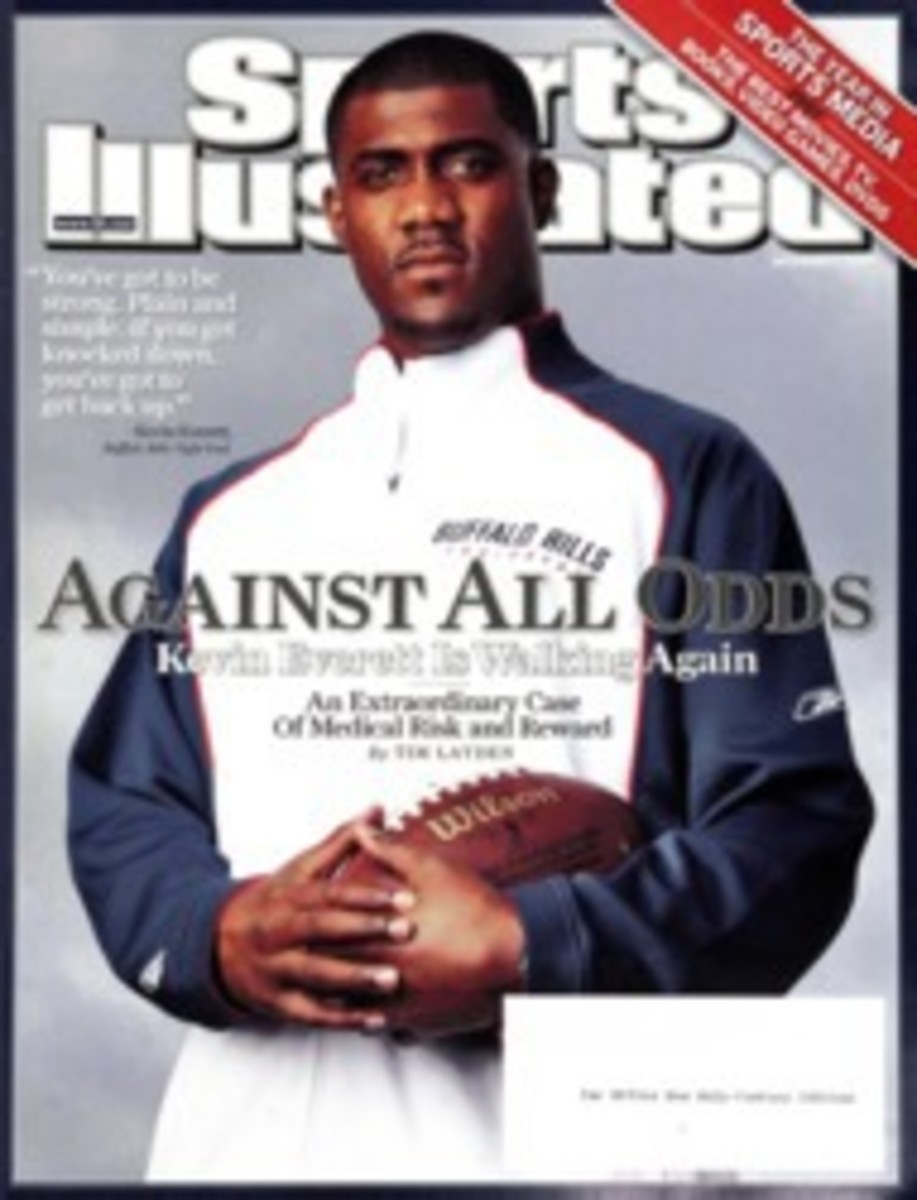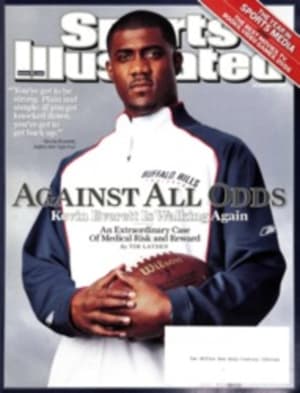
The Well-Read Zone
WHAT WAS it like? John Ed Bradley has heard the question countless times; he knows it's coming as soon as someone discovers that he once played football at LSU. Bradley, a second-team All-SEC center as a senior in 1979, spent much of his postcollegiate life dodging the question. Determined not to be an ex-jock who revels too long in old glories, Bradley downplayed his status as a former athlete, barricading his past from public view.
But while he was cringing at the curiosity of outsiders, Bradley, a novelist, former Washington Post sportswriter and frequent contributor to SI, often found himself reflecting on his days at LSU—drawing comfort from them, even. He finally confronts the question so often asked of him in It Never Rains in Tiger Stadium, his disarmingly honest and bittersweet memoir about his life as an ex-athlete, the best sports book of the year. What was it like? "Always in the back of your mind was the knowledge of your supreme good fortune," Bradley writes. "Everyone else would travel a similar course of human experience, but you were different."
The question, What was it like? is at the heart of most sports books, but in 2007 the best answers seemed to come from authors who focused on football. The Blueprint, by Christopher Price, offers a Moneyball-like look at how coach Bill Belichick and personnel man Scott Pioli built the New England Patriots dynasty. The GM, by Tom Callahan, author of the 2006 best seller Johnny U, goes deeper—into the inner sanctum of former New York Giants general manager Ernie Accorsi. Callahan followed Accorsi through the '06 season, the G.M.'s last before retiring at age 65. Accorsi's candor (reflecting on the Giants' loss to the Ravens in Super Bowl XXXV, he says, "I would love to criticize our offensive game plan, but I don't think we had one") and anecdotes from more than three decades in pro football keep the pages turning, but Callahan succeeds most by revealing the psychological tension within a struggling team. Accorsi's frustration with coach Tom Coughlin grows as the season progresses (New York started 6--2 but finished 8--8), and the two have a confrontation after the season. "I just would like a pat on the back every now and then," Coughlin says. To which Accorsi responds, "You shouldn't need it." It's not just lonely at the top, it's cold.
Down on fan level, though, things can get hot. The heat of passion infuses I Dream in Blue, another book about the Giants, by television writer and producer Roger Director. Like Callahan, Director follows his beloved Giants in 2006—the book is informed by interviews with Tiki Barber, Jeremy Shockey and other players—and gives us an amusing glimpse into the mind of the crazed fan. (When making out his will, Director mentions Barber as a potential guardian for his daughter.) In his more contemplative moments, however, Director realizes that his Giants devotion is an attempt, in middle age, to stay connected to the boy within.
What's it like to be a player? Standard athlete bios often provide unsatisfying answers, but Never Give Up, by Patriots linebacker Tedy Bruschi with Michael Holley, is a candid reflection on the balance pros must strike between preserving their livelihood and their health. Bruschi writes compellingly about the stroke he suffered in 2005 and why—amid media and internal criticism—he decided to return to the field the next season. Bruschi's dedication is something Bradley could appreciate. As he ages and makes peace with his athletic past in It Never Rains, Bradley realizes that football exerts a pull as strong as any familial or civic bond. "There are things we never get over," he writes. "And for me football is one of them."
The Brow Beat
HIGH
In The Happiest Man in the World, Alec Wilkinson profiles Poppa Neutrino, a free-spirited 70-something who crosses the Atlantic on a raft built from trash. Is Neutrino nuts? Maybe, but he'll make you long to quit your desk job.
LOW
Where's the concession stand? It's not Dickens, but it's an apt opening line for I Live for This!, the Tommy Lasorda bio cowritten with Bill Plaschke. Some stories are familiar—he knew Sinatra?—but so is a plate of con vongole, and that's O.K.
Ironing Mike
How one fight changed two lives
EARLY IN
The Last Great Fight author Joe Layden describes the 1994 night when former heavyweight champ Buster Douglas fell into a diabetic coma and nearly died. Yet the years after Douglas's 1990 title win were harsher to the man he beat. In prose that's as sharp as an uppercut, Layden revisits the day Douglas handed Mike Tyson his first loss. A generation of young fans knows Tyson as a novelty act and boxing as a niche sport. Layden traces both declines to that night in Tokyo.
Sharp Shooter
LATE IN
his life Maravich described his youthful self as a "basketball android," seemingly engineered to play the game. In the well-researched Pistol: The Life of Pete Maravich, Mark Kriegel peels back the legend, revealing the complex man behind the floppy-haired LSU star. The Maravich "android" was created by Pete's dad and coach, Press; Kriegel tells his story as well, revealing him to be a driven but loving father who was an inspiration and a burden. The result is the best sports biography of the year.
From SI
NUMEROUS BOOKS
were published by SI Books or written by SI writers this year. SPORTS ILLUSTRATED's The Basketball Book is a hoops celebration in words and pictures. The Hammer is an ode to Hank Aaron from the pages of the magazine, In the Paint collects Swimsuit Issue body-paint art, and Hate Mail from Cheerleaders features the best of Rick Reilly's columns. S.L. Price's Far Afield is a meditation on sports and life written during a year spent abroad. L. Jon Wertheim's Running the Table tells the story of Kid Delicious, the Last Great Pool Hustler. In Jackpot Nation, Richard Hoffer examines why Americans love to gamble. Austin Murphy argues for college football over the NFL in Saturday Rules; Stewart Mandel takes stock of the college game in Bowls, Polls and Tattered Souls. Senior editor Jim Gorant wrote Fanatic: 10 Things All Sports Fans Should Do Before They Die. And senior contributing writer Frank Deford spins the story of a ballplayer accused of a crime in the novel The Entitled.
The Most ...
ILLUMINATING LOOK AT AN ENDURING MYTH
You'd think there's nothing left to say about the 1936 Olympics, but in Triumph: The Untold Story of Jesse Owens ESPN's Jeremy Schaap argues that much of what is believed about the track star's experience at Hitler's Games isn't true. Schaap skillfully separates fact from legend—the sprinter wasn't snubbed by the Nazi leader after winning the 100-meters, for example—without diminishing Owens's hero status.
LIVELY ACCOUNT OF THE DEAD BALL ERA
In Crazy '08, Cait Murphy recounts the tumultuous 1908 season: The Cubs were a powerhouse, the AL and NL pennant races went down to the wire, and Fred Merkle made a mistake he never lived down. Crazy '08 is a richly detailed look at a less-than-wholesome chapter in baseball's past.
ENGAGING TALES OF A FORGOTTEN TEAM
In the early years of the 20th century the country's best football team was the Carlisle Indian School, coached by Pop Warner and starring Jim Thorpe. The squad came back to life this year in Carlisle vs. Army, by SI staff writer Lars Anderson, and The Real All Americans, by Sally Jenkins. They're both finely detailed stories that culminate in Carlisle's symbolic 1912 game against Dwight Eisenhower's Army team.
APPROPRIATE TITLE
Bruce Feldman's Meat Market follows former Ole Miss coach Ed Orgeron as he scours the country for talent, taking readers deep into the swamp of college football recruiting. Feldman describes a system that lives down to a fan's worst expectations.
UNIQUE GLIMPSES OF BOXING ICONS
After shooting Cassius Clay's 1964 win over Sonny Liston, Ken Regan spent four decades taking pictures of the sport's greatest figures. Hundreds of his photos are gathered in Knockout: The Art of Boxing, which captures Ali, Frazier, Tyson and many others at their most menacing and behind the scenes.
REALISTIC TAKE ON A LEGEND
Jonathan Eig's Opening Day casts the breaking of baseball's color barrier in a new light, depicting Jackie Robinson as more fiery and Dodgers players as less supportive than popularly thought. Relying heavily on firsthand accounts by black journalist Wendell Smith, Eig revisits 1947 with an honesty that deepens our appreciation for Robinson.
TEN PHOTOS
PHOTO
BOB JORDAN/US PRESSWIRE (LASORDA)
PHOTO
TONY TRIOLO (DOUGLAS-TYSON FIGHT)
PHOTO
AP (OWENS)
PHOTO
BETTMANN/CORBIS (ROBINSON)

